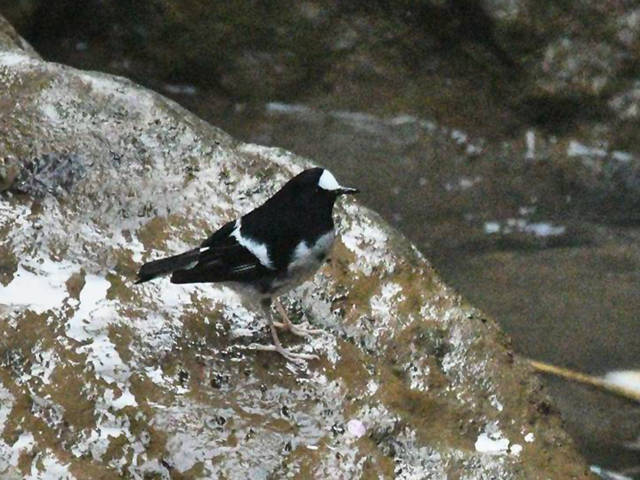search
classification
|
basic information
|
video
|
reports |
Little Forktail
Enicurus scouleri (Vigors, 1832)

|

|
|
|
2022-04-19
Arslanbob |
© Philippe Campeau
|
|
Description
The adult males and females have the black bluish tinged head (except the forehead), neck, craw and back. The wings are black-brown with the broad white across band. The forehead; band across the back; breast and abdomen are white. The tail is dichromatic. The two central pairs of the tail feathers are black-brown with white bases; the outer pair is all white; the other tail feathers are white with the dark terminal spots, less on the outer feathers and larger on the feathers closer to center. The legs are pinkish-white almost white. The bill is black. The eyes are dark-brown. Juveniles have the brownish-black upperparts except the broad white band across the back and wings; and whitish uppertail. The underparts are white with blackish-grey borders on the tips of feathers of the craw and breast.
Biology
The Little Forktail is very rare breeding migrant. It lives in the dashing mountain rills and rivers in the forest and sub-alpine belts on 1300-2900 m. It inhabits near the heady streams with the waterfalls and the stones diffused on the coasts and in the water. The heady mountain streams are the native habitat of this bird which is similar on the Dipper on behavior. Often it is observed on the stone which the water course through. This time the bird moves a little, sometimes its tail fans; the bird easy picks up the food from the water coursed through the stone. But the Little Forktail doesn't content only the food brought by the water; from time to time it abruptly dips from the stone to the water (usually against the current), to the most heavy streams; and hides on the foam as the Dipper do it. But under the water the Forktail eats rarer than Dipper. It is very difficult to behold the bird under the water because the black and white colors of its plumage accord to the black stones and white foam. The flight of the Forktail is equable, quiet; the birds fly low on the water continuing the curves of the river. It eats the water invertebrates and water plants. In the stomachs of the two birds from the Pskem valley there were nymphs and adults flies, water beetles, spiders, insects' eggs, sand and water plants. Breeds in separate pairs at 2-4 km from each other. The nest is built in the rock hollow, behind the waterfalls; often birds get to nest only through the water. Both partners build the nest from the moss and dry grass. Clutches of 3-4 eggs is probably in June. Only female incubates. Independent juvenile observed in mid-August. The vertical migration in winter time depends from the rivers freezing and therefore it isn't well expressed in all areas. In places it may be observed below the forest belt on 900 m, but winter records in Kazakhstan does not exist.
References
"Птицы Казахстана" том 3. "Наука". Алма-Ата, 1970. Gavrilov E. I., Gavrilov A. E. "The Birds of Kazakhstan". Almaty, 2005. Э.И.Гаврилов. "Фауна и распространение птиц Казахстана". Алматы, 1999.


